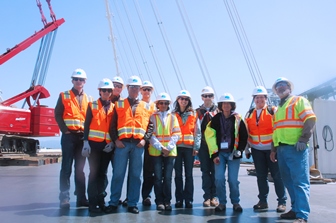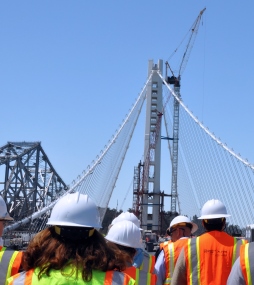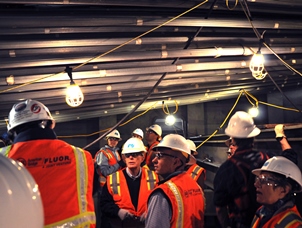 Attendees of the 2013 CEE Alumni Weekend gave high marks to this year’s excursion, which took them to San Francisco from April 25 to April 28.
Attendees of the 2013 CEE Alumni Weekend gave high marks to this year’s excursion, which took them to San Francisco from April 25 to April 28.
But it wasn’t the whimsical cable cars, the Ghirardelli Chocolate, or even the tours of two Napa Valley wineries that made them rave.
It was an exclusive, behind-the-scenes tour of the San Francisco Oakland Bay Bridge, now nearing the end of the multi-billion dollar renovation.
“It’s like Disneyland for engineers,” said Houston-based technical consultant Barry Adelson, CE ’74, one of more than 50 CEE alumni and guests who spent a sunny Saturday crawling around, climbing, and exploring the mammoth structure.
“But it’s more than that, too. In the classroom, you can do calculations to the umpteenth degree, but what counts is whether you can make it work. They have made some big complex calculations on this project. And they are making them work.”
The daylong tour was the first of its kind - the general public has never had such intimate access to the worksite. And it was conducted by engineers from American Bridge Fluor Joint Venture (ABFJV) - the group that is overseeing the mammoth undertaking.
“They call it a miracle, and I think that’s about accurate,” said Ron Stuff, CE ‘82, now an assistant general counsel for Fluor Corporation. “It’s engineering on a grander scale than we’ve ever seen before, but its success was measured in inches.”
Self-professed engineering geek, Charles Nelson, agreed:
“We couldn’t have chosen a better place to spend the day,” said the CE ’70 graduate, now chairman of Waldemar S. Nelson Co., Inc., in New Orleans.
“To build a bridge that would withstand an earthquake that is only remotely likely to happen in 1,500 years is a monumental task. To do that and to make sure it meets the community’s aesthetic standards is, from a design standpoint, amazing.”
Nelson’s sentiments w ere echoed all around.
ere echoed all around.
“When you think of all of the contractors involved in this, it’s really an amazing engineering challenge,” said Jean Souza, ESM ’81, a Berkeley-based systems engineer. “Just to achieve that degree of tolerance - they were within ½ millimeter on a project that was huge – that in itself is an accomplishment.”
Blake Peck, MSCE ’78 said that, even for seasoned engineers, this project was jaw-dropping in its complexity.
“From the outside, it looks like a simple design, but the amount of engineering that went into this was impressive. The transfer of load, the camber, the sheer weight of the bridge and balancing it all so that the tension remained constant.”
Stephanie Box, CE ’10, said she was stunned by the precision of the construction engineers on this project.
“Having access to the inside of the girders, where we saw thousands of cables, all of them supporting the bridge, that was incredible,” she said. “It makes you realize how many components there are – how many details – behind the bridge.”
With the Labor Day opening of the SFOBB fast approaching, public scrutiny (and criticism) has ratcheted up. Lately, questions about some of the materials used in the construction have been making headlines.
ABFJV Project Director Brian Petersen addressed those questions when he talked to the CEE alumni, but also spoke very candidly about the effect this scrutiny has had on his team. Portland, Oregon-based engineer Lyn Wylder, CE ’75, said she could relate to Petersen’s frustration. A project manager for the much scrutinized Columbia River Crossing, she has worked under similar conditions.
Portland, Oregon-based engineer Lyn Wylder, CE ’75, said she could relate to Petersen’s frustration. A project manager for the much scrutinized Columbia River Crossing, she has worked under similar conditions.
“There is a lot of very innovative engineering and hard work going into this project,” she said.
“But when you have a big enough project and it’s an open, public process, you sometimes find that there’s some [journalist] who wants to get a Pulitzer Prize by finding problems that aren’t there. It’s very discouraging. I’m impressed with how they’ve kept going.”
EAB Chairman Chuck Huling, CE ’74, emerged from the tour with the energy and excitement of a newly minted engineer. “This is a massive project – bigger than most of us will ever work on – and yet we got to see parts of the work that not everyone will get to see – ever,” said the executive in residence for the Strategic Energy Institute. “And our tour guides were the engineers themselves, so the challenging questions we had for them made for some great conversations.”
“This is a massive project – bigger than most of us will ever work on – and yet we got to see parts of the work that not everyone will get to see – ever,” said the executive in residence for the Strategic Energy Institute. “And our tour guides were the engineers themselves, so the challenging questions we had for them made for some great conversations.”
His EAB colleague, Rick Zalesky, agreed.
“Very few people will see what we got to see, and we were among the last to get this level of access,” he said. “And when it is done, this bridge will be a showpiece to the world.”

